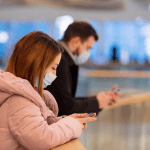
Uncertain prognoses, looming severe shortages of resources for testing and treatment and for protecting responders and health care providers from infection, imposition of unfamiliar public health measures that infringe on personal freedoms, large and growing financial losses, and conflicting messages from authorities are among the major stressors that undoubtedly will contribute to widespread emotional distress and increased risk for psychiatric illness associated with Covid-19. Health care providers have an important role in addressing these emotional outcomes as part of the pandemic response.
Public health emergencies may affect the health, safety, and well-being of both individuals (causing, for example, insecurity, confusion, emotional isolation, and stigma) and communities (owing to economic loss, work and school closures, inadequate resources for medical response, and deficient distribution of necessities). These effects may translate into a range of emotional reactions (such as distress or psychiatric conditions), unhealthy behaviors (such as excessive substance use), and noncompliance with public health directives (such as home confinement and vaccination) in people who contract the disease and in the general population. Extensive research in disaster mental health has established that emotional distress is ubiquitous in affected populations — a finding certain to be echoed in populations affected by the Covid-19 pandemic.
After disasters, most people are resilient and do not succumb to psychopathology. Indeed, some people find new strengths. Nevertheless, in “conventional” natural disasters, technological accidents, and intentional acts of mass destruction, a primary concern is post-traumatic stress disorder (PTSD) arising from exposure to trauma. Medical conditions from natural causes such as life-threatening viral infection do not meet the current criteria for trauma required for a diagnosis of PTSD,1 but other psychopathology, such as depressive and anxiety disorders, may ensue.
Some groups may be more vulnerable than others to the psychosocial effects of pandemics. In particular, people who contract the disease, those at heightened risk for it (including the elderly, people with compromised immune function, and those living or receiving care in congregate settings), and people with preexisting medical, psychiatric, or substance use problems are at increased risk for adverse psychosocial outcomes. Health care providers are also particularly vulnerable to emotional distress in the current pandemic, given their risk of exposure to the virus, concern about infecting and caring for their loved ones, shortages of personal protective equipment (PPE), longer work hours, and involvement in emotionally and ethically fraught resource-allocation decisions. Prevention efforts such as screening for mental health problems, psychoeducation, and psychosocial support should focus on these and other groups at risk for adverse psychosocial outcomes.
Beyond stresses inherent in the illness itself, mass home-confinement directives (including stay-at-home orders, quarantine, and isolation) are new to Americans and raise concern about how people will react individually and collectively. A recent review of psychological sequelae in samples of quarantined people and of health care providers may be instructive; it revealed numerous emotional outcomes, including stress, depression, irritability, insomnia, fear, confusion, anger, frustration, boredom, and stigma associated with quarantine, some of which persisted after the quarantine was lifted. Specific stressors included greater duration of confinement, having inadequate supplies, difficulty securing medical care and medications, and resulting financial losses.2 In the current pandemic, the home confinement of large swaths of the population for indefinite periods, differences among the stay-at-home orders issued by various jurisdictions, and conflicting messages from government and public health authorities will most likely intensify distress. A study conducted in communities affected by severe acute respiratory syndrome (SARS) in the early 2000s revealed that although community members, affected individuals, and health care workers were motivated to comply with quarantine to reduce the risk of infecting others and to protect the community’s health, emotional distress tempted some to consider violating their orders.3
Opportunities to monitor psychosocial needs and deliver support during direct patient encounters in clinical practice are greatly curtailed in this crisis by large-scale home confinement. Psychosocial services, which are increasingly delivered in primary care settings, are being offered by means of telemedicine. In the context of Covid-19, psychosocial assessment and monitoring should include queries about Covid-19–related stressors (such as exposures to infected sources, infected family members, loss of loved ones, and physical distancing), secondary adversities (economic loss, for example), psychosocial effects (such as depression, anxiety, psychosomatic preoccupations, insomnia, increased substance use, and domestic violence), and indicators of vulnerability (such as preexisting physical or psychological conditions). Some patients will need referral for formal mental health evaluation and care, while others may benefit from supportive interventions designed to promote wellness and enhance coping (such as psychoeducation or cognitive behavioral techniques). In light of the widening economic crisis and numerous uncertainties surrounding this pandemic, suicidal ideation may emerge and necessitate immediate consultation with a mental health professional or referral for possible emergency psychiatric hospitalization.
On the milder end of the psychosocial spectrum, many of the experiences of patients, family members, and the public can be appropriately normalized by providing information about usual reactions to this kind of stress and by pointing out that people can and do manage even in the midst of dire circumstances. Health care providers can offer suggestions for stress management and coping (such as structuring activities and maintaining routines), link patients to social and mental health services, and counsel patients to seek professional mental health assistance when needed. Since media reports can be emotionally disturbing, contact with pandemic-related news should be monitored and limited. Because parents commonly underestimate their children’s distress, open discussions should be encouraged to address children’s reactions and concerns.
As for health care providers themselves, the novel nature of SARS-CoV-2, inadequate testing, limited treatment options, insufficient PPE and other medical supplies, extended workloads, and other emerging concerns are sources of stress and have the potential to overwhelm systems. Self-care for providers, including mental health care providers, involves being informed about the illness and risks, monitoring one’s own stress reactions, and seeking appropriate assistance with personal and professional responsibilities and concerns — including professional mental health intervention if indicated. Health care systems will need to address the stress on individual providers and on general operations by monitoring reactions and performance, altering assignments and schedules, modifying expectations, and creating mechanisms to offer psychosocial support as needed.
Given that most Covid-19 cases will be identified and treated in health care settings by workers with little to no mental health training, it is imperative that assessment and intervention for psychosocial concerns be administered in those settings. Ideally, the integration of mental health considerations into Covid-19 care will be addressed at the organizational level through state and local planning; mechanisms for identifying, referring, and treating severe psychosocial consequences; and ensuring the capacity for consulting with specialists.4
Education and training regarding psychosocial issues should be provided to health system leaders, first responders, and health care professionals. The mental health and emergency management communities should work together to identify, develop, and disseminate evidence-based resources related to disaster mental health, mental health triage and referral, needs of special populations, and death notification and bereavement care. Risk-communication efforts should anticipate the complexities of emerging issues such as prevention directives, vaccine availability and acceptability, and needed evidence-based interventions relevant to pandemics and should address a range of psychosocial concerns. Mental health professionals can help craft messages to be delivered by trusted leaders.4
The Covid-19 pandemic has alarming implications for individual and collective health and emotional and social functioning. In addition to providing medical care, already stretched health care providers have an important role in monitoring psychosocial needs and delivering psychosocial support to their patients, health care providers, and the public — activities that should be integrated into general pandemic health care.
[“source=nejm”]







